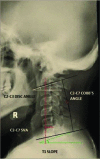Which factors predict the loss of cervical lordosis following cervical laminoplasty? A review of various indices and their clinical implications
- PMID: 31528482
- PMCID: PMC6744746
- DOI: 10.25259/SNI_339_2019
Which factors predict the loss of cervical lordosis following cervical laminoplasty? A review of various indices and their clinical implications
Abstract
Background: Many patients undergoing laminoplasty develop postoperative loss of cervical lordosis or kyphotic alignment of cervical spine despite sufficient preoperative lordosis. This results in poor surgical outcomes.
Methods: Here, we reviewed the relationship between multiple radiological parameters of cervical alignment that correlated with postoperative loss of cervical lordosis in patients undergoing laminoplasty.
Results: Patient with a high T1 slope (T1S) has more lordotic alignment of the cervical spine preoperatively and is at increased risk for the loss of cervical lordosis postlaminoplasty. Those with lower values of difference between T1S and Cobb's angle (T1S-CL) and CL-T1S ratio have higher risks of developing a loss of the cervical lordosis postoperatively. Alternatively, C2-C7 lordosis, neck tilt, cervical range of motion, and thoracic kyphosis had no role in predicting the postlaminoplasty kyphosis.
Conclusion: Among various radiological parameters, the preoperative T1S is the most important factor in predicting the postoperative loss of the cervical lordosis/alignment following laminoplasty.
Keywords: C2-C3 disc angle; C2-C7 Cobb’s angle; C2-C7 lordosis; C2-C7 sagittal vertical axis; Cervical laminoplasty; Loss of cervical lordosis; T1 slope.
Conflict of interest statement
There are no conflicts of interest.
Figures
References
-
- Baba H, Uchida K, Maezawa Y, Furusawa N, Azuchi M, Imura S, et al. Lordotic alignment and posterior migration of the spinal cord following en bloc open-door laminoplasty for cervical myelopathy: A magnetic resonance imaging study. J Neurol. 1996;243:626–32. - PubMed
-
- Cho JH, Ha JK, Kim DG, Song KY, Kim YT, Hwang CJ, et al. Does preoperative T1 slope affect radiological and functional outcomes after cervical laminoplasty? Spine (Phila Pa 1976) 2014;39:E1575–81. - PubMed
-
- Kawaguchi Y, Kanamori M, Ishihara H, Ohmori K, Nakamura H, Kimura T, et al. Minimum 10-year followup after en bloc cervical laminoplasty. Clin Orthop Relat Res. 2003;411:129–39. - PubMed
-
- Kim P, Murata H, Kurokawa R, Takaishi Y, Asakuno K, Kawamoto T, et al. Myoarchitectonic spinolaminoplasty: Efficacy in reconstituting the cervical musculature and preserving biomechanical function. J Neurosurg Spine. 2007;7:293–304. - PubMed
-
- Kim TH, Lee SY, Kim YC, Park MS, Kim SW. T1 slope as a predictor of kyphotic alignment change after laminoplasty in patients with cervical myelopathy. Spine (Phila Pa 1976) 2013;38:E992–7. - PubMed
Publication types
LinkOut - more resources
Full Text Sources
Miscellaneous

